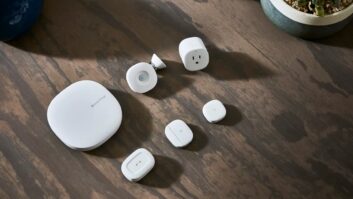
San Francisco – Home networking is gradually being accepted by consumers, but several hurdles, including ease of use and compatibility, have to leaped before it becomes a mass market business.
That was the view of panelists on the “Home Networking Trifecta” panel during the Consumer Electronics Association (CEA) Fall Forum on Monday.
The panel, moderated by Colin Dixon, senior partner of The Diffusion Group (TDG), included Kurt Hoppe, smart TV innovation director, LG; Jay McLellan, president of Home Automation Inc. (HAI); Kevin Meagher, VP/general manager of smart homes with Lowe’s; and Brett Wingo, VP/general manager, Cisco Home Networking.
In his opening remarks Dixon said that in 2006 by a two –to-one margin home office was the preferred place for home networking use, with the living room second. “Now it has reversed to the living room… thanks to Netflix,” and other uses.
LG’s Hoppe said his company has several divisions involved with web-based products, including smart TV, mobile communications and appliances. One of the important goals for LG is to “make sure standards are open” so products can easily communicate with each other.
He added that tablets and smartphones “are not only used today while watching TV, they can be used to control them too,” which is why LG is “giving the tools to developers” to make sure standards stay open.
McLellan welcomed the notion of open standards and mentioned that 20 years ago CEA attempted to do a “one-size-fits-all” approach with the CE Bus effort, but the industry found that didn’t work. More than one standard may be needed, McLellan said, “because we need what is right for the job at hand.”
Lowe’s Meagher said all home products will eventually be linked to the web and standards have to be set because, “Nobody wants to go to 14 different websites of 14 different device makers to find out why something doesn’t work.”
He stressed that the “talk about standards has got to stop, or else we will be talking about it for another ten years.” Two of the standards Lowe’s likes are Wi-Fi and ZigBee.
Cisco’s Wingo said an Internet connection “is the lifeblood of the home today.” Between mobile devices and smart TVs a home network is a necessity, and, he added, the home network has to work with the cloud, as well.
The problem is, “We – all of the related industries here – have done a poor job of explaining the concept to consumers.”
Wingo said consumers have turned to Apple’s “closed garden” as he called it, of content and mobile devices because it works.
On the home side, appliances, TVs and security systems are examples of networked devices desired by consumers, but that industry is behind when it comes to filling the need.
Wingo, when asked by Dixon about ease of use, said Cisco backs open standards like near field communication, which drives services such as Google Wallet.
Hoppe of LG said appliances are now Wi-Fi connected and diagnostics can be performed and sent to tablets, smartphones and even a TV to alert consumers when their laundry is done, for example.
Hoppe hinted that LG will be talking at CES in January about refrigerators that can tell consumers what foods they need to shop for, as well as home control and energy management.
There was also a discussion on home health services via home networks. Cisco’s Wingo said that Wi-Fi with cellular as a backup could be a way to go for these applications.
However, the retailer on the panel, Meagher of Lowe’s, stressed that this industry needs to make home networking a mass market product. “Reliability is the key. We need embedded apps that can solve [consumer] problems,” adding, “We all love neat devices [for home networking]. We have them now. What we need is integrated solutions to get the market to the second level.”
Dixon of TDG summed that point up, saying, “I have the title for next year’s panel: ‘Killer App for the Intelligent Home!’ ”













